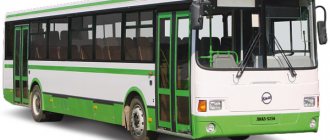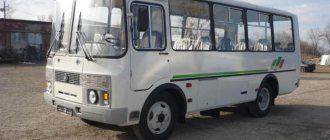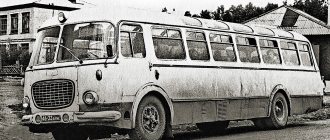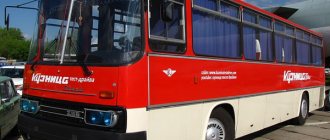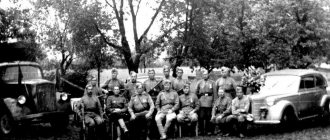Bus PAZ-672. Photo Wikipedia
PAZ-672 is a Soviet small-class bus, produced by the Pavlovsk Bus Plant in 1967-1989. The predecessor is PAZ-652, the successor is PAZ-3205. PAZ-672 buses were intended for regional and suburban routes with low passenger traffic, although they were and are used in cities, often as minibuses, service buses or hearses.
History of creation
The development of the PAZ-672 bus began in 1957. This was a further development of the PAZ-652B model. The bus uses an 8-cylinder V-engine and chassis from a GAZ-53 truck , power steering. At the same time, the PAZ-750 passenger trailer was developed (not mass-produced).
Bus PAZ-672. Photo Wikipedia
The technical design was ready at the end of 1958 . The first prototype, which looked little different from the PAZ-652, was manufactured in November 1959 . In the process of further work on the bus, the identified shortcomings of the PAZ-652 were taken into account, as well as new developments on the GAZ-52 and GAZ-53 trucks. In December 1960, a new version of the PAZ-672 appeared. The base of the body was used from the PAZ-652B, the braking system received a separate drive for the front and rear axles. Three prototypes were built in 1961 and 1963. After departmental tests at the end of 1963, the bus was recommended for mass production.
In 1964, the body frame was completely redesigned, its weight was reduced, and the size of the side windows increased. The new version of the bus was embodied in metal for the May Day holidays. It was planned to produce five hundred buses by the end of the year. But preparations for production took a long time. It was not possible to start production in both 1965 and 1966. The first serial PAZ-672 saw the light only in 1967. In the meantime, new modifications of the bus were being developed. In total, about two dozen prototypes were built.
On October 25, 1967, the first two bodies of serial PAZ-672 were welded in assembly shop No. 2. A month later, four buses rolled off the assembly line of assembly shop No. 1, and a total of ten vehicles were delivered by the end of the year. In November 1968, production of the PAZ-652B was discontinued, and the plant completely switched to the production of PAZ-672.
In December 1969, a decision was made to modernize the bus. The engine life was increased, the reliability of the power steering and brakes was increased, and the body was sealed. Changes were made constantly. However, this did not affect the bus index in any way. There is a misconception that the bus modernized in the early 1970s began to be called PAZ-672B, but there was no modification of the PAZ-672 bus with the index “B” according to the technical documentation. Since 1975, the resource before overhaul was increased to 320 thousand km, from 1979 - to 330 thousand km.
In 1980, the modernized PAZ-672M , which had a service life of 350 thousand km before overhaul, was tested at the NAMI test site. Production of the PAZ-672M began in December 1982 . It is worth mentioning separately the features of the external lighting equipment of the bus. Another erroneous opinion is that new front direction indicators and side lights, as well as square-shaped rear lights assembled into a single vertical section, began to be installed on PAZ-672M buses, that is, since 1982. In fact, the installation of new lighting equipment that complies with UNECE rules was carried out in stages in 1978. First, the rear lights were installed, leaving the front direction indicators unchanged, and then the bus was equipped with new front direction indicators combined with side lights.
Production of the PAZ-672M bus ceased on November 30, 1989. It gave way to the more modern PAZ-3205 bus on the assembly line.
Comes from childhood
PAZ-672 was the first thing you saw in the mid-1990s when you got off the train at Chupa station in northern Karelia. My great-uncle also worked there on a bus like this. One day he took me with him, sat me down in a “criminal” seat near the engine compartment, I wrote a “station station” sign in clumsy letters, and we set off on our flight.
25 years have passed since my last trip on a pasik. Therefore, today, when I entered the cabin of this bus, I not only found myself in childhood, but also moved in my memories 1800 kilometers north of Minsk. And already my son took a ride on the “thieves” place.
– We all come from childhood. I remember the first time my parents let me go to my grandmother alone, I went to her in a groove. It always stretched, it was hot in the summer. It's part of childhood. And then you grow up, and such toys appear,” says Oleg.
– I drove a PAZ to a music school for five years. And when we purchased this bus, we plunged into childhood memories. Today, when you drive it on the highway, truck drivers honk and show their thumbs. In the city, drivers of modern buses break into smiles. Children react especially coolly, as there is something about this bus that attracts them, probably the cute, attractive design. It’s surprising, because the kids never saw these buses,” Vitaly continues.
Detailed description, device
Bus PAZ-672. Photo Wikipedia
The PAZ-672 cabin is equipped with 23 passenger seats, the total capacity is 45 people , with possible short-term occupancy of up to 58 people. The small size of the windows was compensated by auxiliary ones at the base of the sloping roof. Narrow, pneumatically operated doors could admit one passenger at a time. an individual door to the driver's cabin ; the cabin itself was separated from the passengers by a curtain or a light partition. The body ceiling had 6 ventilation flaps.
PAZ-672 adopted from GAZ-52A : 115-horsepower, 4-stroke, overhead valve carburetor engine with a useful volume of 4.25 liters, power 115 hp; manual, 4-speed gearbox and front axle. The carburetor was located in the front overhang of the car, which caused the first door to be displaced. The machine's clutch is 1-disc, dry, hydraulically driven. The dependent spring suspension included liquid telescopic shock absorbers ZIL-157, which reliably dampen body vibrations during movement and ensure good adhesion of the wheels to the road surface and a smooth ride. The PAZ-672 bus had a split drum brake drive with hydraulics and a vacuum booster.
The end of 1982 was marked by the release of modernized PAZ 672M . The classic bus 672 was inferior to it in some respects. The modernized equipment was distinguished by increased engine power, a safe design of the seats (soft trim on the tubular frame of the seat back), as well as the presence of thermal and noise insulation along the interior, mounted on the engine department panel. In the course of further development, the number of hatches on the ceiling of the bus was reduced from 6 to 4, which worsened the ventilation parameters in the cabin. In the updated model, the design of the front end was changed - in addition to the standard headlights, two fog lights were added, and the turn indicators were enlarged.
In addition, the PAZ-672M brand was used to refer to other 1-door PAZ-672 models manufactured after 1982. Their distinctive feature was the exclusion of the door at the end of the cabin. This model was in high demand in the late 80s. due to the fact that enterprises began to use them as company cars. In 1989, the car plant suspended production of the PAZ-672M. However, this model is still found on the roads.
Long road to serial production
The development of 672s began back in 1957. The chassis for the bus, as well as the 8-cylinder engine, which had the shape of the Latin letter V, was borrowed from the GAZ-53 truck. At the same time, another development was underway (which never became widespread) - a passenger trailer of the PAZ-750 brand.
By the end of the next year (1958), the development of the technical part of the project was completed. The first prototype appeared another year later - in the last autumn month of 1959. At first glance, it was practically no different from its prototype.
PAZ-672
The next version of the updated passenger vehicle was assembled in 1960. There were no shortcomings identified during the use of the PAZ-652. But new developments appeared: the brake system received a separate drive. Three more prototypes were built in 1961 and 1963. And only in 1963, after improvements and changes, it was decided to begin serial assembly of buses.
The series didn't work out. A year later, the body was changed beyond recognition: its weight was significantly reduced, including by increasing the area of the side windows. By May 1, an updated version of the PAZ-672 appeared. According to the factory plan, half a thousand of these machines were to be assembled by the end of the year. However, the plans did not come true. Preparations for the mass production of new PAZs lasted for two years.
The total number of prototypes was about twenty pieces. Some of them (5 pieces) participated in a motor rally that began in Pavlovo, reached the capital of Armenia, Yerevan, and ended in the same Pavlovo. And serial grooves appeared only in 1967, when work began on the next bus model.
Modifications
- PAZ-672 (1967-1982) - basic serial bus.
- PAZ-672A (1967-1968) - a pleasure and excursion vehicle (experimental), with a lightweight roof, without side glazing. 2 buses were built.
- PAZ-672B (1973-1982) - modernized. 117,286 buses were produced.
- PAZ-672V (1970) - chassis. It was the base of the body with the engine, radiator, gearbox and steering.
- PAZ-672VYu (1973-1989) - tropical chassis. It was supplied to Cuba, where it was used for the production of Giron brand buses. 21,100 chassis manufactured.
- PAZ-672G (1983-1986) - mountain. It was distinguished by two 105 liter fuel tanks, seat belts on each seat, power steering and reinforced brakes, the absence of a rear passenger door and glazing in the roof slopes. 575 buses were produced.
- PAZ-672D (1972) - diesel (experimental). 2 buses were built.
The PAZ-3201 bus is a modification of the 672nd model. Photo Wikipedia
- PAZ-672ZH (1985-1989) - gas cylinder. Developed jointly with the Ryazan Gas Equipment Plant. It was distinguished by gas cylinders installed in the rear of the roof. Some auto companies have independently converted buses to use gas fuel.
- PAZ-672M (1982-1989) - modernized. Some buses were produced with one passenger door, due to which two seats were added.
- PAZ-672S (1969-1989) - in the northern version. It was distinguished by double-glazed windows and without vents, the absence of windows in the roof slopes, an additional interior heater, a more powerful generator, and the presence of a second battery. 7,147 buses were produced.
- PAZ-672T - tourist. It featured hinged passenger doors, soft seats with tilt-adjustable backrests, folding luggage nets, and extended springs. Produced in small batches.
- PAZ-672TL (1978-1979) - a mobile laboratory for a comprehensive study of athletes on two buses. 10 sets were produced.
- PAZ-672U (1969-1981) - export. Delivered to European socialist countries and Mongolia.
- PAZ-672UM (1981-1989) - modernized export.
- PAZ-672UM (Olympic series) (1979-1980) - buses to serve the personnel of the 1980 Moscow Olympic Games, members of the Olympic delegations and other needs of the organizing committee. They were distinguished by improved finishing. 50 buses were produced.
- PAZ-672Yu (1970-1989) - export tropical. It was distinguished by the use of corrosion-resistant materials, special rubber and plastics, the absence of glazing in the roof slopes, and an additional gas tank. Delivered to countries in Africa, Southeast Asia and Cuba.
- PAZ-3201 (1972-1982) - all-wheel drive bus. It did not have a back door, due to which the number of seats was increased to 26 (a batch of buses with two doors was produced for the 1980 Olympics). Intended for use in off-road conditions.
- PAZ-320101 (1982-1989) - a modernized all-wheel drive bus.
- PAZ-320107 (1975-?) - tropical chassis.
- PAZ-3201S (1973-1989) - northern. It was distinguished by double-glazed windows and without vents, and the absence of windows in the roof slopes. 6,114 buses were produced.
- PAZ-3742 (1977-1989) - a refrigerator for transporting perishable products. PAZ produced 806 refrigerators. Since 1978, the Baku Specialized Vehicles Plant has been involved in production. In 1980, production was completely transferred to BZSA. The popular name for these buses is “penguins” (due to the image of a pair of penguins on the back door of the refrigerator).
- PAZ-37421 (1977-1989) - isothermal van. It differed from the PAZ-3742 in the absence of a refrigeration unit. PAZ produced 254 vans. Since 1980 it has been produced at BZSA.
- PAZ-3916 (1978-1979) - television control room. Developed jointly with the Kirovograd Radio Products Plant. 22 hardware units were manufactured.
- KT-201 (? -1982) - ritual (hearses). Converted by the Arzamas Municipal Engineering Plant from the serial PAZ-672. The bus had a back door and special runners for the coffin; passenger seats were located along the sides.
- KT-201A (1982-1989) - ritual based on the PAZ-672M.
- BakAZ-3219 (1989-1993) - a passenger bus based on the BZSA-3742, with a remote refrigeration unit, cut out windows and built-in seats. It was produced as a result of an oversupply of components for the BZSA-3742 refrigerators. Also, the BakAZ plant (the new name of the Baku Specialized Vehicles Plant) produced a medical laboratory based on the passenger BakAZ-3219.
“Serial life” PAZ-672
The assemblers welded the very first two PAZ-672 bodies belonging to the series on October 25, 1967. A month later, the first 4 buses appeared. The total number of buses produced in 1967 was 10. At the end of 1968, the plant thoroughly began producing a new model, completely stopping the assembly of the old PAZ-652B.
PAZ-672
Another year passed and the bus was modernized again. This time the engine power has increased, the brake system and power steering have become more reliable. In addition, the body was sealed. The bus was constantly being improved. It was believed that due to numerous improvements, it was assigned the PAZ-672B brand. This opinion is wrong, such a brand did not exist at all.
By 1975, a bus could travel 320,000 km before overhaul; four years later, this figure increased by another 10,000 km. In 1980, the modernized PAZ-672M improved the figure by 20,000 km. This model was tested by NAMI at its own test site, and at the very end of 1982 its mass production began. The number of buses with the prefix “M” assembled over 7 years was 90,645 units.
PAZ-672
Those who claim that new lighting equipment (front markers and turn signals, as well as rear square lights combined into one vertical) were installed only on modernized grooves, more precisely since 1982, are mistaken. In fact, lighting devices that meet the requirements established by the UNECE have been introduced in stages since 1978.
The rear lights were installed first. The second is the front turn signals, combined with side lamps.
The production of PAZ-672M was completed on the last day of November 1989. From that moment on, the plant began to assemble the PAZ-3205, a model more in line with the requirements of the time.
The total number of assembled PAZ-672s is 190,150 units and 98,538 PAZ-672Ms.
Basic information, characteristics
Manufacturer/manufacturer where the equipment is produced/manufactured. Pavlovsky Bus is a Soviet and Russian manufacturer of small and medium class buses. Located in the city of Pavlovo, Nizhny Novgorod region. Part of the GAZ group. Since 2005, bus production has been carried out by PAZ LLC, a 100% subsidiary of Pavlovsky Bus PJSC.
Purpose. For regional and suburban routes with low passenger traffic, suitable for use in cities, often as minibuses or hearses. The scope of application also included business and registered transportation. Along with KAvZs and GAZs, PAZ equipment was in the car garages of many enterprises and organizations. These buses were also used on intercity routes.
Class. Small.
Body type. Car layout.
Which class
PAZ buses are found in both small and medium capacity classes. They differ in the number of seats and dimensions. Small buses are used in the city and suburbs. Their length does not exceed 6-8 meters , the capacity is no more than 40 passengers, and there are up to 20 seats (PAZ-320402).
Medium buses are produced up to 9.5 m long , accommodate up to 60 passengers and have no more than 30 seats (PAZ-320414 Vector). Most often they are used for urban transportation.
Bus PAZ-320414-04 Vector 8.8. Photo RusbusinessAuto
Large buses were produced in a small batch, their length did not exceed 12 m , there were 30-40 seats. Capacity was up to 90 passengers. They were supposed to be used as urban and intercity ones.
Reference! In 2000, there was an attempt to establish the production of medium and large class buses. Small batches of the two-door PAZ-4230 and three-door PAZ-5272 had virtually no chance of winning the competition with the established and advertised production of full-size NefAZ and LiAZ buses. The average PAZ-4230 faded into the background due to the high demand for small class buses.
Engine/powertrain characteristics
- Type. Petrol.
- Number and arrangement of cylinders. 8V.
- Supply system. Carburetor.
- Working volume, l. 4,25.
- Engine power, hp/min. 115.
- Maximum torque, Nm/min. 284.
- Engine location. Front.
- Checkpoint. Mechanical, four-speed.
- Control fuel consumption at 60 km/h, l/100 km. 21.
- Maximum speed, km/h. 80.
Advantages
PAZ Vector 8.8 intercity. Photo GAZ
Passenger transport developed and produced by the Pavlovsk Bus Plant is in high demand due to such advantages as:
- large model range;
- reliability;
- increased passenger capacity;
- attractive appearance and modern interior design;
- affordable price;
- good handling and maneuverability;
- high technical characteristics;
- low cost and availability of components, high wear resistance;
- minimum fuel consumption for such transport;
- quick payback;
- possibility of operation in difficult road conditions thanks to a reliable suspension.
Capacity and dimensions
These parameters depend on the model and class of the bus . For example, modifications of the small class PAZ-3204 bus are produced with a capacity of 42-60 seats. Interior height – 1.98 m, length – 7.6 m, width – 2.41 m, bus height – 2.88 m. Base – 3.8 m.
Bus PAZ-4234. Photo GAZ
And modifications of the high-floor middle class bus PAZ-4234 have a capacity of 52-56 passengers. Bus length – 8.165 m, width – 2.53 m, height – 2.88 m.
Despite the fact that the improved PAZ-4230 "Aurora" with a rear engine is already driving on Russian roads, and the PAZ-3237 is often used as urban public transport, new modifications of front-engine small-class buses of the PAZ models are being produced in small batches and are being tested for certification. -3203 and PAZ-3204. Old PAZ models are still
Fuel
PAZ produces buses with both traditional gasoline and diesel engines of various modifications. The diesel version of the engine allows you to reduce operating consumption by almost 10 liters . Tank volume 100-150 liters.
For gasoline engines, the manufacturer recommends using unleaded gasoline Normal 80 , GOST R 51105, duplicate options - Regular-92, Premium-95, A-92, A-95, classes 3 and 4 according to the technical regulations “On the requirements for automobile and aviation gasoline, diesel and marine fuel..."
School bus PAZ-320370-08, diesel. Photo RusbusinessAuto
Diesel fuel, if the bus is equipped with the appropriate type of engine, must be used in accordance with GOST R 52368-2005 type II or III, class 4 or 5 fuel according to the technical regulations “On the requirements for automobile and aviation gasoline, diesel and marine fuel...”
Driver's seat
Driver's seat in the PAZ-3237 bus. Photo YarCamp
The driver's position has changed a bit since the eighties, when the first models went into production. It is moved towards the door and therefore a bit cramped. However, the “PAZIKS” are distinguished by good visibility and good handling (tight levers only at the transfer case).
Now there is a high partition behind the driver’s back that protects from drafts. The high beam control button has been moved in many models from the floor to the steering column switch. Heated rear-view mirrors appeared . The steering wheel is comfortable in terms of rim thickness and diameter.
The dashboard and seat have changed, currently most suitable for a person of average height. The seat is adjustable in the horizontal plane. You can change the angle of the backrest. There is suspension .
The internal location of the motor allows you to make minor repairs without leaving the cabin. This is convenient in low temperatures or in the rain.
Special transport
A research strain gauge laboratory was constructed on the basis of the all-wheel drive PAZ-672 TL. The new product differed from the standard bus by the presence of a solid continuous roof and two internal partitions in the body. Only 10 copies were produced (1980) by order for the Olympics.
A few more examples can be noted:
- 672 U - export version for regions with temperate climates.
- 672 Yu - for tropical countries. The solid roof has lost glass inclusions, the main color is white with multi-colored lines.
- Based on the PAZ-672, the all-wheel drive bus 3201 was manufactured. The main differences are the absence of a rear door, a higher seating position, and the number of seats has increased to 26.
- Refrigerators for transporting perishable goods (modification 3742). Serial production of the machines began in 1981. Later, the production was transferred to the Baku plant for the production of special equipment. At first, ready-made vehicles for the installation of refrigeration units were supplied to Baku, then only some basic spare parts for PAZ-672.
- Mobile television station (model 3916). The working equipment was provided by the Kirovograd Radio Engineering Products Plant. The complex included four television cameras, a pair of video recorders, a radio channel, director and sound consoles. Only 16 such copies were produced.
- VgArZ is a mobile blood collection complex produced at the car assembly plant in Voroshilovgrad.
- The KT-201 version had a frame and engine from PAZ-672, and was manufactured in Arzamas. The main purpose is to provide funeral services. There is a hatch in the rear wall of the car for the coffin; the seats are located along the sides of the bus. The outer part of the equipment had a distinctive sign in the form of a wide black stripe.
Category
Buses PAZ-32053 and 4234 and their modifications (for example, 423470-04) are produced in accordance with Appendix No. 7 to the “Consolidated Resolution on Vehicle Design” as belonging to the MZ category of class II and class I-II. Class I buses are produced with 245/70R 19.5 tires.
“Goozes” comply with the conditions of GOST 15150. They are intended for operation at temperatures from −45°C to +40°C. Buses are designed to transport passengers on roads of I, II, III operating categories , but are not intended for travel in areas with mountainous terrain.
